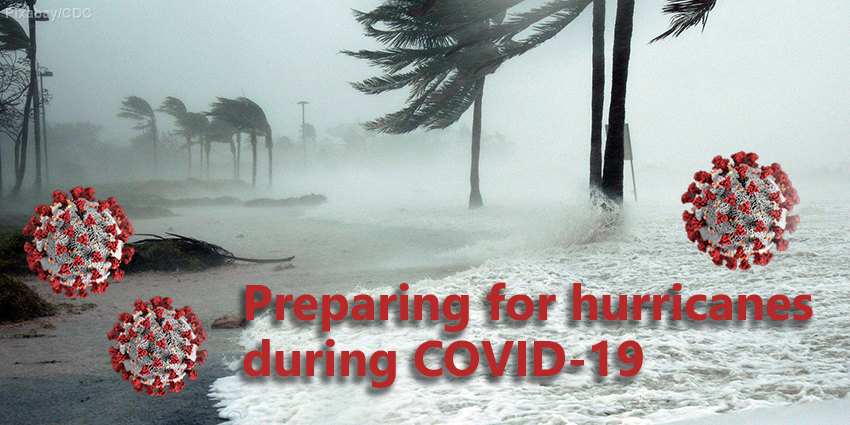Article originally written by Chantal Cough-Schulze
As a likely active hurricane season starts, the COVID-19 pandemic may complicate preparation and response, experts say.
The 2020 Atlantic hurricane season is “expected to be a busy one,” said Gerry Bell, Ph.D., lead hurricane season forecaster with the National Oceanic and Atmospheric Administration’s (NOAA) Climate Prediction Center, in a teleconference with reporters on May 21.
The Climate Prediction Center forecasted the likely above-normal hurricane season could include 13 to 19 named storms, which are storms with winds of 39 miles per hour or higher. Of those, 6 to 10 could become hurricanes (winds of 74 miles per hour or higher), including 3 to 6 major hurricanes (winds of 111 miles per hour or higher).
The Atlantic hurricane season started June 1 and goes through November 30. But two named storms, Arthur and Bertha, formed in May, marking the sixth consecutive year in which a named storm has developed ahead of the official hurricane season. On the second day of the official season, Tropical Storm Cristobal became the earliest third named Atlantic storm on record, two months ahead of the average date. The storm made landfall in Mexico on June 3 and again in southeastern Louisiana on June 7, bringing heavy rain and flooding to parts of the Gulf Coast before traveling north.
“The ingredients for an above-normal season seem to be falling in place,” said John Nielsen-Gammon, Ph.D., Texas State Climatologist and Regents Professor in Texas A&M University’s Department of Atmospheric Sciences.
The likelihood of an above-normal season is driven by several factors, Nielsen-Gammon said. Sea surface temperatures in the tropical Atlantic are warmer than normal, and vertical wind shear, which can stop storms from forming or becoming stronger, is reduced. There is also an enhanced West African monsoon.
These factors are partly a result of the El Niño-Southern Oscillation (ENSO), a recurring climate pattern of changing sea surface temperatures in the central and eastern tropical Pacific Ocean. During the El Niño phase of ENSO, those temperatures are warmer, and during La Niña, they are cooler. El Niño tends to suppress Atlantic hurricane activity, while La Niña tends to strengthen it. Current ENSO conditions are neutral — tropical Pacific sea surface temperatures are closer to average — and are expected to either remain neutral or trend toward La Niña.
The exact impacts of the 2020 hurricane season are difficult to predict, Nielsen-Gammon said, because different storms produce different results.
“It’s not just the number of storms; it’s where they go,” he said. “Hurricane Harvey could have completely dissipated over the Yucatán, but instead it turned north, reintensified and produced over a hundred billion dollars of damage in Texas.”
Hurricane prep during a pandemic
As hurricane season ramps up, preparations are underway in Texas. COVID-19, which has infected nearly 75,000 Texans, is further complicating preparations.
“In typical Texas fashion, we are dealing with multiple challenges at one particular time,” said Gov. Greg Abbott during a June 5 press conference on state hurricane preparations.
Populations that have been hit particularly hard by COVID-19, such as people of color, the elderly and low-income people, may also be some of the most vulnerable in hurricanes, said Michelle Meyer, Ph.D., director of Texas A&M’s Hazard Reduction & Recovery Center.
Historically, hurricane response involves filling buses with evacuees and taking them to large, often crowded shelters, such as gymnasiums, convention centers and church basements, which could now become disease hot spots. The built-in support systems in times of disaster — family and friends — are also riskier to lean on during the pandemic, Meyer said.
“Our social networks are there to help, but evacuating to family and friends might be something that requires a little bit more pre-planning,” she said. “You might not be able to go there, or maybe you shouldn’t go there.”
With COVID-19 in mind, the Texas Department of Emergency Management (TDEM) is taking additional precautions this hurricane season, said officials at the governor’s June 5 press conference. These include earlier evacuations, using more vehicles for evacuation, decreasing the number of people per shelter and using motels and hotels to help support sheltering needs. TDEM is also working to ensure that additional cleaning teams, cleaning supplies and personal protective equipment will be available at each shelter.
The standard battery of individual hurricane preparations — knowing your risk, making an emergency plan, building a disaster kit and getting connected with emergency notification systems — still applies this season, said Carlos Castillo, acting deputy administrator for resilience at the Federal Emergency Management Agency, in NOAA’s teleconference. Disaster kits should now also include supplies recommended by the U.S. Centers for Disease Control and Prevention to help prevent the spread of COVID-19, such as face masks, gloves and hand sanitizer, he said.
When it comes to recovery, building community resilience will be vital, Meyer said.
“One thing people can do beyond protecting themselves is contact their local fire department, nonprofits or houses of worship,” she said. “Say, ‘Okay, hurricane season could be bad. How can we help? How can we prepare our institution to be ready to help?’”
In the end, Nielsen-Gammon said, the best way to prepare for an above-normal hurricane is the same as for any other hurricane season — with as much advance planning as possible.
“Whether the forecast is for an above active season or a season that’s less active than normal, it’s still hurricane season, and it only takes one hurricane,” Nielsen-Gammon said. “You don’t want to mess with hurricanes. You want to be prepared for them no matter what the forecast is.”



